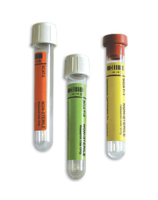FOR VETERINARY USE ONLY!
Tubes are non-sterile. We recommend phlebotomy be done with a catheter of at least five inches in length, which is equipped with a multi-sample luer adapter (MSLA).
SCAT-ACT tubes have not been validated in any controlled animal studies, and Prolytix makes no claims of performance or suitability as a screening test for coagulopathy. The responsibility for achieving accurate and clinically useful results with SCAT-ACT tubes rests solely with the Veterinarian and/or individual performing the test. Good laboratory practice dictates that each clinic should establish its own reference values by running 5 to 10 known normal animals.
Handling and Use of the Prolytix SCAT-ACT blood collection tube
This document describes the process for handling and using the SCAT-ACT blood collection tube. These tubes are intended for veterinary use only, and are not sterile.
- The tubes should be stored at room temperature. These tubes do not need to be refrigerated, and should not be frozen.
- Prior to collection, a water bath or heating block should be set to 37°C.
- Preheat the collection tubes to be used to 37°C for 5-10 minutes.
- The accuracy of this test depends on the tubes being at as close to 37°C as possible to eliminate prolonged or variable results which can occur at room temperature.
- Perform a clean venipuncture of the cephalic (leg) vein, and discard the first 1-2 mL of blood to eliminate any extrinsic clotting activation.
- A timer should be started once the SCAT-ACT tube begins collection.
- The tube should be gently rocked five times, and placed back into the 37°C water bath or heating block.
- After 50 seconds, the tube should be removed and checked for clotting by gently tilting the tube lengthwise in front of a light source.
- Replace the tube in the heat source and continue to check every 5 seconds.
- Once an unmistakable thickening or clumping has formed the timer should be stopped. Do not wait for a complete, solid clot to stop the timer.
Normal Values:
Dogs < 120 seconds
Cats < 100 seconds
Cow < 145 seconds
Horse < 45 seconds
* The above values are taken from the literature from use with tubes of a different brand, and should only be used as a guideline.

